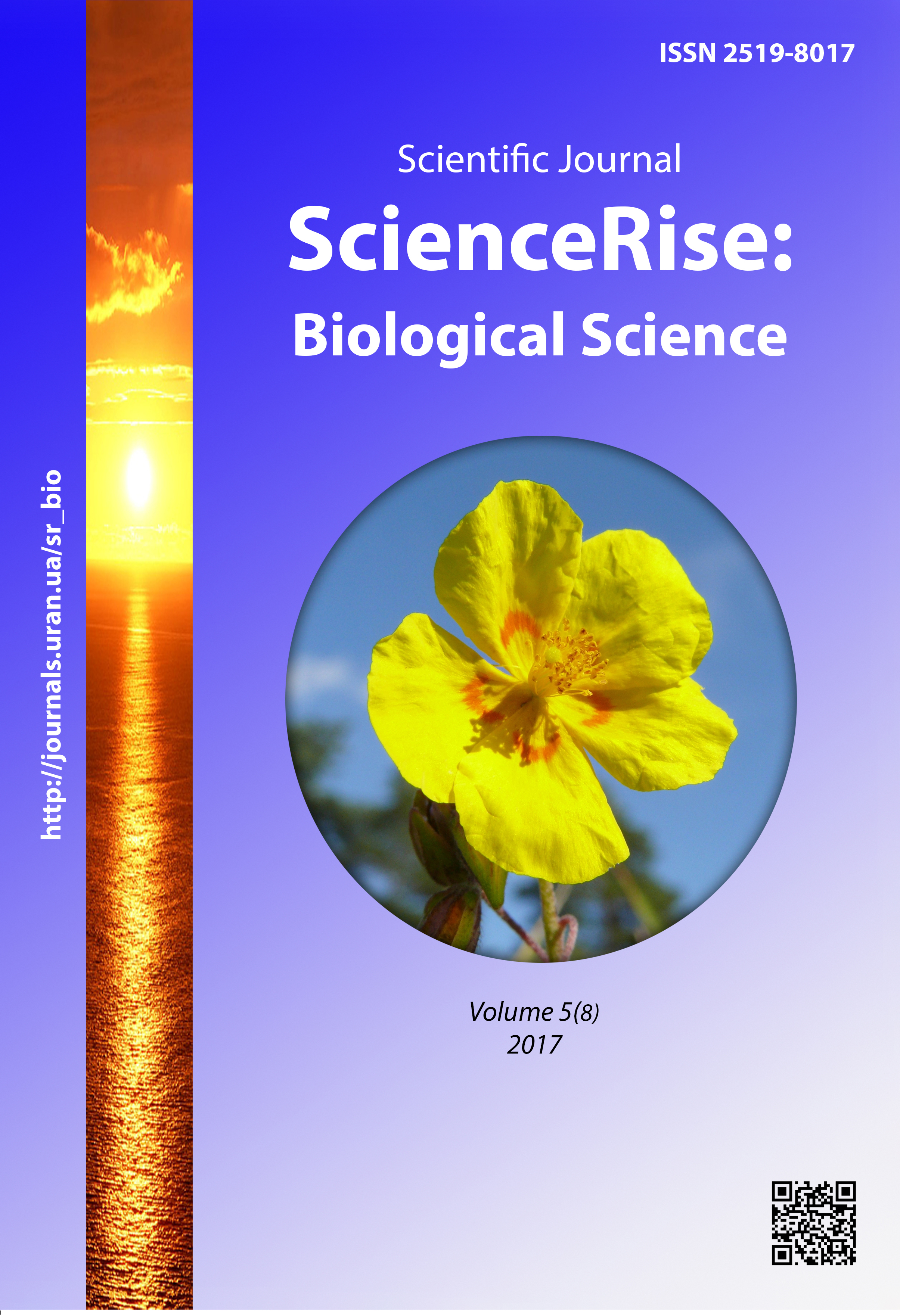Аналіз селено- та хромовмісних сполук як перспективного класу біологічно активних добавок
DOI:
https://doi.org/10.15587/2519-8025.2017.113575Ключові слова:
біологічно активні добавки, селен, хром, водорості, сполуки, цукровий діабет, засвоєнняАнотація
Дефіцит селену та хрому у продуктах харчування, обумовлює зниження даних мікроелементів в організмі, що веде до розвитку патологічних процесів. Використання біологічно активних добавок різного походження дозволяє в більшій чи меншій мірі поповнити запас мікроелементів. Біологічно активні добавки органічної природи мають перевагу над їх неорганічними сполуками та чинять більший терапевтичний ефект при порушеному метаболізмі
Посилання
- Ekmekcioglu, C. (2001). The role of trace elements for the health of elderly individuals. Nahrung/Food, 45 (5), 309. doi: 10.1002/1521-3803(20011001)45:5<309::aid-food309>3.0.co;2-0
- Larsen, H. J. S. (1993). Relations between selenium and immunity. Norw. J. Agr. Sci., 11, 105–119.
- Forceville, X., Vitoux, D., Gauzit, R., Combes, A., Lahilaire, P., Chappuis, P. (1998). Selenium, systemic immune response syndrome, sepsis, and outcome in critically ill patients. Critical Care Medicine, 26 (9), 1536–1544. doi: 10.1097/00003246-199809000-00021
- Jeejeebhoy, K. N. (1999). Chromium and parenteral nutrition. The Journal of Trace Elements in Experimental Medicine, 12 (2), 85–89. doi: 10.1002/(sici)1520-670x(1999)12:2<85::aid-jtra5>3.0.co;2-z
- Cefalu, W. T., Hu, F. B. (2004). Role of Chromium in Human Health and in Diabetes. Diabetes Care, 27 (11), 2741–2751. doi: 10.2337/diacare.27.11.2741
- Amberg, R., Mizutani, T., Wu, X.-Q., Gross, H. J. (1996). Selenocysteine Synthesis in Mammalia: An Identity Switch From tRNASerto tRNASec. Journal of Molecular Biology, 263 (1), 8–19. doi: 10.1006/jmbi.1996.0552
- Gromova, O. A., Gogoleva, I. V. (2007). Selenium – impressive results and prospects. Difficult patient, 14, 13–17.
- Gamoshinskiy, M. D. (2007). Selen v pitanii cheloveka. Ter. arkhyv. na zdobuttia nauk. stupenia kand. biol. nauk, 3, 6–10.
- Shabunin, S. V., Vostroilova, G. A., Belyaev, V. I., Balym, Yu. P. (2007). Toxicological characteristic of seledant. Veterinary science, 8, 20–25.
- Ortman, K., Pehrson, B. (1999). Effect of selenate as a feed supplement to dairy cows in comparison to selenite and selenium yeast. Journal of Animal Science, 77 (12), 3365. doi: 10.2527/1999.77123365x
- Vincent, J. B. (2000). Elucidating a Biological Role for Chromium at a Molecular Level. Accounts of Chemical Research, 33 (7), 503–510. doi: 10.1021/ar990073r
- Stoecker, B. J. (1999). Chromium absorption, safety, and toxicity. The Journal of Trace Elements in Experimental Medicine, 12 (2), 163–169. doi: 10.1002/(sici)1520-670x(1999)12:2<163::aid-jtra13>3.0.co;2-3
- Zolotorova, O. K., Shniukova, E. I., Sivash, O. O., Mikhailenko, N. F. (2008). Prospects for the use of microalgae in biotechnology. Kyuv: AlterPress, 234.
- Minyuk, G. S., Drobetskaya, I. V. (2000). Effect of selenium on the life of marine and freshwater microalgae. Ecology of the sea, 54, 26–37.
- Kim, Y. J., Kwon, S., Kim, M. K. (2009). Effect of Chlorella vulgaris intake on cadmium detoxification in rats fed cadmium. Nutrition Research and Practice, 3 (2), 89. doi: 10.4162/nrp.2009.3.2.89
- Lee, H. S., Park, H. J., Kim, M. K. (2008). Effect of Chlorella vulgaris on lipid metabolism in Wistar rats fed high fat diet. Nutrition Research and Practice, 2 (4), 204. doi: 10.4162/nrp.2008.2.4.204
- Vinjarska, G., Bodnar, O., Stanislavchuk, A., Grubinko, V. (2014). Accumulation of selenium in lipids Chlorella vulgaris Beijer in vitro. Y International Conference "Actual problems in modern phycology". Chisinau, Moldova, 153–158.
- Balabolkin, M. N., Klebanova, E. M. (2000). The role of oxidative stress in the pathogenesis of vascular complications of diabetes. Problems of endocrinology, 6, 34.
- Topachevsky, A. V. (1975). Methods of physiological and biochemical study of algae in hydrobiological practice. Kyiv: Naukova dumka, 247.
- Lukashiv, O. Ya. (2017). Metabolic processes in rats at experimental type 2 diabetes, by the action of inorganic and organic compounds of selenium and chromium. Materials of the All-Ukrainian Scientific and Practical Internet Conference. Berdyansk: BDPU, 194–196.
- Viniarska, H. B., Bodnar, O. I., Vasilenko, O. V., Stanislavchuk, A. V. (2016). Chapter 15: Accumulation and Effects of Selenium and Zinc on Chlorella Vulgaris Beij. (Chlorophyta) Metabolism. Heavy Metals and Other Pollutants in The Environment, 293–314. doi: 10.1201/9781315366029-19
- Lukashiv, O. Y., Bodnar, O. I., Vinyarskа, H. B., Hrubinko, V. V. (2016). Effect of Selenium-Chrome-Lipid Substance From Chlorella Vulgaris Biej. On Oxidative Status of Rats. Medical and Clinical Chemistry, 18 (2), 28–34. doi: 10.11603/mcch.2410-681x.2016.v0.i2.6667
- Vinyarskaya, G., Bodnar, O., Stanislavchuk, A., Grubinko, V. (2014). Accumulation of selenium in lipids Chlorella vulgaris Beijer. (CHLOROPHYTA) in vitro. Actual problems in modern phycology, Conferinṭӑ Internationalӑ. Y International Conference «Actual problems in modern phycology». Chişinӑu: CEP USM, 153–158.
- Gennity, J. M., Bottino, N. R., Zingaro, R. A., Wheeler, A. E., Irgolic, K. J. (1984). The binding of selenium to the lipids of two unicellular marine algae. Biochemical and Biophysical Research Communications, 118 (1), 176–182. doi: 10.1016/0006-291x(84)91083-0
- Selenium (2003). Alternative Medicine Review, 8 (1), 63–71.
- Recommended Dietary Allowances (1989). Washington. doi: 10.17226/1349
##submission.downloads##
Опубліковано
Як цитувати
Номер
Розділ
Ліцензія
Авторське право (c) 2017 Olga Lukashiv, Vasil Grubinko

Ця робота ліцензується відповідно до Creative Commons Attribution 4.0 International License.
Наше видання використовує положення про авторські права Creative Commons CC BY для журналів відкритого доступу.
Автори, які публікуються у цьому журналі, погоджуються з наступними умовами:
1. Автори залишають за собою право на авторство своєї роботи та передають журналу право першої публікації цієї роботи на умовах ліцензії Creative Commons CC BY, котра дозволяє іншим особам вільно розповсюджувати опубліковану роботу з обов'язковим посиланням на авторів оригінальної роботи та першу публікацію роботи у цьому журналі.
2. Автори мають право укладати самостійні додаткові угоди щодо неексклюзивного розповсюдження роботи у тому вигляді, в якому вона була опублікована цим журналом (наприклад, розміщувати роботу в електронному сховищі установи або публікувати у складі монографії), за умови збереження посилання на першу публікацію роботи у цьому журналі.










